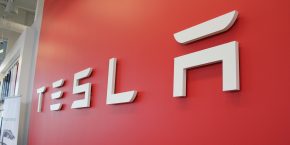

The U.S. Department of Energy invests in early stage energy projects through its Advanced Research Projects Agency-Energy, or ARPA-E, in order to develop breakthrough technologies that could make renewable energy cheaper and better.
ARPA-E Director Dr. Ellen Williams (on the right above), a chemist best known for her research in surface chemistry and for being former chief scientist at BP, gave an interview this week in which she made controversial remarks about Tesla Motors’ work on battery technology. She highlighted Tesla’s battery manufacturing initiative, but added that it is not technology innovation.
Williams said in the interview (via Reuters):
“What Musk (Tesla CEO) has done that is creative and important is drive the learning curve. He’s decided to take an existing, pretty powerful battery technology and start producing it on a very large scale.
But it’s not technology innovation in the sense of creating new ways of doing it. We are pretty well convinced that some of our technologies have the potential to be significantly better.”
To be fair to the automaker, although it didn’t reveal any next generation energy technology like ARPA-E seems to be focused on, Tesla’s effort to improve both battery pack and battery cell technology have been well-documented. The automaker has been recognized for its innovative battery pack system which safely manages thousands of individual cylindrical battery cells. Most electric vehicles today use rectangular pouch cells believed to be easier to secure in an automotive battery pack application.
When Tesla first revealed the Roadster’s battery pack, it was something no one had ever seen before and could easily be considered an “innovation”. Then Tesla CEO Martin Eberhard wrote about the technology in a 2006 blog post:
“Our battery system – or Energy Storage System, as we like to call it – is comprised of 6,831 individual Li-ion cells. It’s roughly the size of a storage trunk and weighs about 900 pounds. Nestled securely in the back of the Tesla Roadster, the battery system is the secret behind our four second 0-60 mph acceleration and phenomenal driving range. To achieve this kind of performance, we were meticulous about our battery technology selection. Batteries are not perfect – no doubt about it. Though market forces continue to drive improvements in batteries, the Li-ion battery system in the Tesla Roadster represents the very best of today’s commercially available battery technology.”
Tesla developed its own module buses, fuses, cooling systems and battery management systems, but of course the battery cells themselves are manufactured by Panasonic – likely the “pretty powerful battery technology” Williams was referring to. With the upcoming Gigafactory in Nevada, Tesla is trying to also contribute in improving the cell technology, as well as cost, which is aligned with ARPA-E’s goal to make renewable energy cheaper and better.
At the AGU Fall Meeting last year, Tesla CEO Elon Musk confirmed that the battery cells Tesla plans to manufacture at the factory (still in partnership with Panasonic) will be different from the current ones used in the Model S and X, and that the cells will feature “moderate” technology improvements. Cell production is expected to start later this year at the Gigafactory.
The automaker currently uses nickel cobalt aluminum (NCA) battery cells for its vehicles and its back-up power battery packs like the 10 kWh Powerwall. For the 7 kWh daily cycling Powerwall, the company uses nickel manganese cobalt oxide (NMC) cells, which typically have a longer cycle life, but less energy density.
The company didn’t reveal any detail about the battery cell improvements.
When it comes to energy storage technologies, there’s certainly room for both incremental improvements on existing tech, what Tesla’s seems to be focusing on with the Gigafactory, and the next generation technologies Williams’ agency is financing.
ARPA-E was founded in 2009 with $400 million in public fund. The Obama administration 2017 budget proposal includes an increase to $1 billion the agency’s budget over five years.
You can visit ARPA-E’s website to see the agency’s list of projects.
FTC: We use income earning auto affiliate links. More.




That’s a typical fallacy of bureaucrats, and experts. They think innovation is only about technology. In fact, there are ten types of innovation. With her argument the iPhone wasn’t a technology innovation either. The Tesla car isn’t either, because all the technologies were known, right? So where’s the innovation?
The innovation comes from combining multiple innovation types, such as packaging a great (=product performance) battery for home use (=product system) in an affordable way (=business model) through a different =channel (which means non-utility) by a company with a track record of great high-performance batteries (=brand). That combination makes it an extremely powerful innovation.
Before she talks about innovation, she should learn about it.
A former BP chemist should know the difference between a technological innovation (which involves basic science) from a practical, right-now-being-manufactured technology which can be continuously improved (as Tesla has done). Tesla is not in the basic science business. They’re making practical products on a mass scale using leading-edge technologies which can be manufactured in consumer quantities at reasonable cost.
Sounds like she’s a closet clean coal proponent. What would they know about real-life battery use.
Well if she is, she knows more about batteries then you ever will.
Clean coal proponents know more about batteries than I ever will? Hmm, I would not have thought that was clean coals area of expertise.